PyIncentiveBC: A Python Module for Simulation of Incentivization Mechanism Implemented in Blockchain-Based Systems
Abstract
1. Introduction and Motivation
- Development of PyIncentiveBC, a Python-based, open-source simulator designed to assess the reliability of incentivization mechanisms in blockchain systems.
- Implementation of a dynamic, proportionate reward and penalty mechanism that addresses the inefficiencies in current blockchain incentivization methods.
- Provision of a modular framework that allows for easy integration and extension by the research community to benchmark and evaluate various approaches.
2. Related Work
3. Reward and Punishment System Description
- A portion newly created at the time of mining, called Leader Reward (LR). This is directly disbursed to the elected Leader node through a consensus algorithm.
- The other part, known as Transaction Fees (TF), is already encapsulated in transactions previously grouped in the created block and disseminated by the Leader node for future validation.
- Penalties (P) recovered from malicious nodes during the preceding mining round (5).
- A portion of the GR not disbursed to participants (referred to as Saved Reward, or SR) but allocated for future nodes participating in upcoming mining cycles (6). The ultimate aim of this accumulation is to incentivize nodes to participate in future mining rounds and enable them to benefit, for as long as possible, from transaction fees and penalties collected during previous mining cycles.
4. Tool Setup and Underlying Equations
- Approach 1: Normal ApproachIn the ‘normal’ approach, only the leader node receives the final reward (FR), which includes the leader’s remuneration (LR) and the total transaction fees (TF) for the current round (Formula (1)). Other participants, despite their contributions and incurred costs, do not receive any reward.
- Approach 2: Improved approachThe calculation of the final reward (FR) adopted by the second approach (Formula (2)) applies to every node that participated in the mining and validation round. This approach allows the leader node to receive the rewards appropriate to it (LR), but after deducting any penalties (P) associated with the percentage of its non-conformity. In contrast to the normal approach, the improved approach also enables the other participating nodes to receive their rewards (PR), funds for which are collected from previous rounds. These rewards are also subject to deductions based on the degree of conformity of each node. The details of the various calculations are well-described in Appendix B.
5. Implementation and Usage
5.1. Software Architecture
5.2. Software Functionalities
- The first category concerns the initialization step (__init__()), during which the elementary attributes, namely the list of participating nodes, the list of simulation rounds, the rewards assigned to the nodes per round (e.g., leader reward, transaction fee)—are initialized.
- The second category includes the methods defining the consensus algorithms implemented to designate a Leader for each simulation round, particularly when the list of leader nodes is not predefined. In the first illustrative scenarios with synthetic exemplary data, we used a single consensus algorithm for the two implemented approaches. This consensus algorithm consists of electing nodes in turn.
- The functions containing the definitions of the implemented approaches belong to the third category of methods. Indeed, the methods “start_approach_1()”, “start_approach_2()” contain the different processes necessary to implement the approach in question and ultimately provide a two-dimensional data structure type output named DataFrame whose data can be easily manipulated via its various attributes and methods [42].
- The fourth method category (“compare_approaches()” and “plot_graph_X()”) makes it possible to carry out the elementary processing operations ensuring the comparison of the results obtained by the implemented approaches, preparing and structuring the data necessary to allow the end user to visualize the results in different forms: data structure or graph.
5.3. Enhanced Accessibility through CodeOcean and Documentation
- CodeOcean Container: PyIncentiveBC has been published as an executable container on CodeOcean [43], a platform designed for reproducible and traceable computational science. This container requires no installation or configuration, as the environment and package dependencies are pre-installed. Users can run the code directly on the platform, either with default inputs or customized parameters, and easily visualize and download the outputs generated. The container faithfully replicates the original development environment, allowing seamless integration into existing workflows, desktop or web GUIs, and Jupyter notebooks.
- Comprehensive Documentation and guide: We have developed extensive documentation and a step-by-step guide to assist users further. These resources offer detailed instructions on the installation, setup, and execution of the tool, making it accessible even to those with limited technical expertise. The documentation and guide, detailed in the README.md file, are available on our GitHub and CodeOcean repositories, ensuring that users can easily access the support they need to utilize PyIncentiveBC effectively.
6. Test Cases: Illustrative Scenarios and Real-World Case Studies
6.1. Illustrative Scenarios with Synthetic Exemplary Data
- -
- leader_reward = 10.0;
- -
- transaction_fees = 2.0;
- -
- saved_part = 0.1;
- -
- distributed_part = 0.9.
6.2. Real-World Case Study
6.2.1. Methodology
- Data Collection: We obtained Bitcoin block data from Blockchair [44], a blockchain analytics engine, on 11 August 2024. This dataset, spanning blocks 856,222 to 856,382, includes information about the miner (block creator), the reward amount generated, and the total transaction fees for each block (Table 1).
- Miner Evaluation: We evaluated each miner based on two criteria, retrieved on 10 August 2024, related to their previous activities:
- –
- Average Block Health (AvgBH): A measure of how many transactions appear intentionally excluded from a block. 100% health indicates no intentionally excluded transactions [45].
- –
- Empty Blocks Mined (EBM): Retrieved from the “mempool.space” platform over the past 24 months, this represents the number of blocks the miner created that contain no transactions [46]. Although Bitcoin’s protocol rewards empty blocks, we propose adjusting the reward structure to penalize this practice, encouraging miners to include transactions and improve network efficiency.
- Score Calculation: We calculated a score for each miner using Formula (A7), considering two rules as previously mentioned: Node’s Block Health (NBH), based on the AvgBH value, and Preventing Empty Blocks (PEB), based on EBM.The Conformity Rate (CR) quantifies the degree of adherence to a specified rule, with values closer to 1 indicating a higher level of compliance by the participant. The Conformity Rate for the NBH rule is calculated as (Formula (3)):while the Formula (4) determines the Conformity Rate for the PEB rule:The final scores for known miners were calculated as described in Table 2.The Coefficient for each rule is set to 1, representing full weight in the final score.Given the inherent difficulty in retrieving the historical data of anonymous nodes (unknown miners), it is not feasible to construct a history-based score for them. Consequently, we propose assigning these nodes the lowest score derived from our calculations. This approach ensures that participants with known participation histories are not unfairly disadvantaged.
- Simulation: We used PyIncentiveBC to simulate two scenarios: (a) The current Bitcoin reward mechanism (Approach 1); (b) Our proposed dynamic, proportionate incentivization mechanism (Approach 2) (Figure 10).
6.2.2. Results
7. Impact
7.1. Research & Scientific
7.2. Education
8. Conclusions and Outlook
Author Contributions
Funding
Institutional Review Board Statement
Informed Consent Statement
Data Availability Statement
Conflicts of Interest
Abbreviations
| AvgBH | Average Block Health |
| CR | Conformity Rate |
| EBM | Empty Blocks Mined |
| FR | Final Reward |
| GR | Generated Reward |
| IR | Initial Reward |
| LR | Leader Reward |
| MN | Malicious Node |
| NBH | Node’s Block Health |
| NPN | Non-Participating Node |
| P | Penalties |
| PEB | Preventing Empty Blocks |
| PN | Participating Node |
| PoS | Proof of Stake |
| PoW | Proof of Work |
| PR | Participating Reward |
| SR | Saved Reward |
| TF | Transaction Fees |
Appendix A. Normal Approach (Approach 1)
Appendix B. Improved Approach (Approach 2)
- Transaction fees (TF),
- The sum of the penalties debited from the nodes in the previous round of mining (),
- Part of the GR from the previous mining cycle (PrevGR) (Formula (A5)).
- If the node is designated as Leader, the penalties will be deducted from Leader Reward (LR);
- For other participating nodes, penalties will be deducted from Participating Reward (PR).
Appendix C. Comparative Analysis of Bitcoin Raw Rewards Distribution: Normal vs. Proposed Approaches
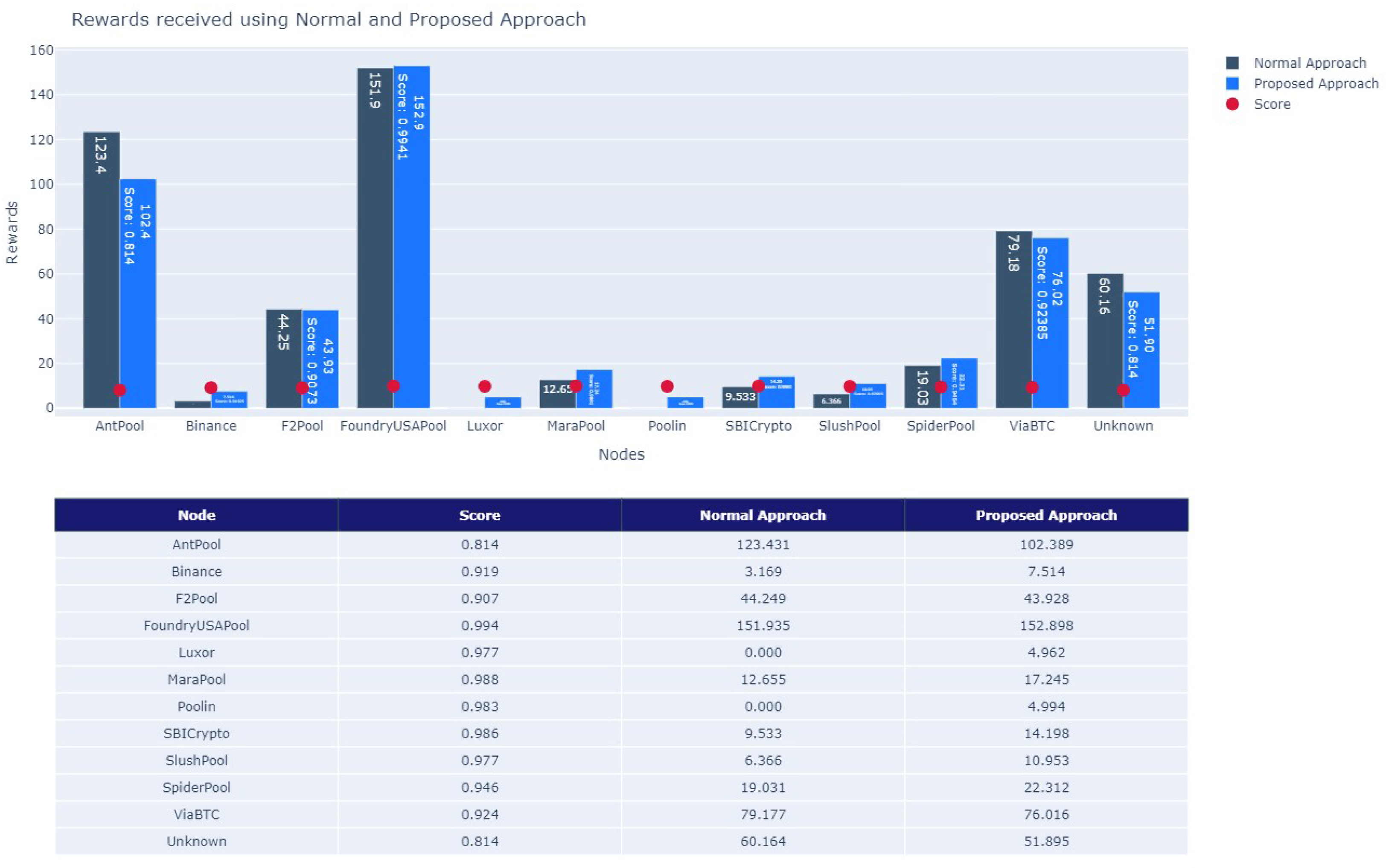

| Round | Leader Reward 1 | Transaction Fees 1 | Leader Reward 2 | Transaction Fees 2 | Saved Reward | Penalties |
|---|---|---|---|---|---|---|
| 1 | 3.125 | 0.060 | 3.125 | 0.060 | 0.000 | 0.000 |
| 2 | 3.125 | 0.060 | 3.125 | 0.060 | 0.006 | 0.584 |
| 3 | 3.125 | 0.027 | 3.125 | 0.027 | 0.065 | 0.275 |
| 4 | 3.125 | 0.032 | 3.125 | 0.032 | 0.037 | 0.599 |
| 5 | 3.125 | 0.049 | 3.125 | 0.049 | 0.067 | 0.613 |
| 6 | 3.125 | 0.053 | 3.125 | 0.053 | 0.073 | 0.064 |
| 7 | 3.125 | 0.027 | 3.125 | 0.027 | 0.019 | 0.030 |
| 8 | 3.125 | 0.040 | 3.125 | 0.040 | 0.008 | 0.585 |
| 9 | 3.125 | 0.029 | 3.125 | 0.029 | 0.063 | 0.058 |
| 10 | 3.125 | 0.030 | 3.125 | 0.030 | 0.015 | 0.588 |
| 11 | 3.125 | 0.028 | 3.125 | 0.028 | 0.063 | 0.612 |
| 12 | 3.125 | 0.028 | 3.125 | 0.028 | 0.070 | 0.615 |
| 13 | 3.125 | 0.032 | 3.125 | 0.032 | 0.071 | 0.063 |
| 14 | 3.125 | 0.034 | 3.125 | 0.034 | 0.017 | 0.029 |
| 15 | 3.125 | 0.034 | 3.125 | 0.034 | 0.008 | 0.023 |
| 16 | 3.125 | 0.041 | 3.125 | 0.041 | 0.007 | 0.242 |
| 17 | 3.125 | 0.030 | 3.125 | 0.030 | 0.029 | 0.037 |
| 18 | 3.125 | 0.028 | 3.125 | 0.028 | 0.010 | 0.024 |
| 19 | 3.125 | 0.027 | 3.125 | 0.027 | 0.006 | 0.584 |
| 20 | 3.125 | 0.030 | 3.125 | 0.030 | 0.062 | 0.324 |
| 21 | 3.125 | 0.030 | 3.125 | 0.030 | 0.042 | 0.601 |
| 22 | 3.125 | 0.069 | 3.125 | 0.069 | 0.067 | 0.613 |
| 23 | 3.125 | 0.033 | 3.125 | 0.033 | 0.075 | 0.281 |
| 24 | 3.125 | 0.051 | 3.125 | 0.051 | 0.039 | 0.600 |
| 25 | 3.125 | 0.033 | 3.125 | 0.033 | 0.069 | 0.277 |
| 26 | 3.125 | 0.028 | 3.125 | 0.028 | 0.038 | 0.599 |
| 27 | 3.125 | 0.040 | 3.125 | 0.040 | 0.067 | 0.276 |
| 28 | 3.125 | 0.030 | 3.125 | 0.030 | 0.038 | 0.042 |
| … | … | … | … | … | … | … |
| 159 | 3.125 | 0.037 | 3.125 | 0.037 | 0.039 | 0.600 |
| 160 | 3.125 | 0.024 | 3.125 | 0.024 | 0.039 | 0.614 |
| 161 | 3.125 | 0.053 | 3.125 | 0.053 | 0.070 | 0.615 |
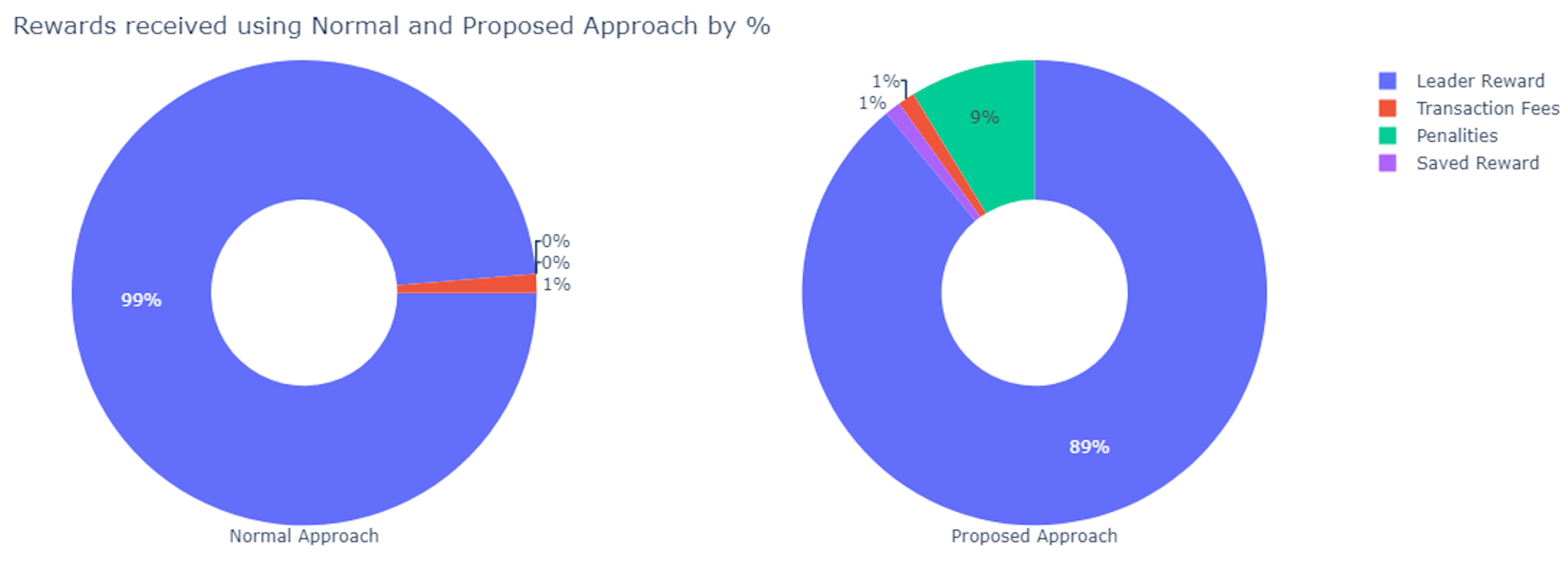
References
- Padmavathi, U.; Rajagopalan, N. Concept of blockchain technology and its emergence. In Research Anthology on Convergence of Blockchain, Internet of Things, and Security; IGI Global: Hershey, PA, USA, 2023; pp. 21–36. [Google Scholar]
- Pragasam, T.T.N.; Thomas, J.V.J.; Vensuslaus, M.A.; Radhakrishnan, S. CEAT: Categorising Ethereum Addresses’ Transaction Behaviour with Ensemble Machine Learning Algorithms. Computation 2023, 11, 156. [Google Scholar] [CrossRef]
- Bellaj, B.; Ouaddah, A.; Bertin, E.; Crespi, N.; Mezrioui, A.; Bellaj, K. BTrust: A New Blockchain-Based Trust Management Protocol for Resource Sharing. J. Netw. Syst. Manag. 2022, 30, 64. [Google Scholar] [CrossRef]
- Ren, Y.S.; Ma, C.Q.; Chen, X.Q.; Lei, Y.T.; Wang, Y.R. Sustainable finance and blockchain: A systematic review and research agenda. Res. Int. Bus. Financ. 2023, 64, 101871. [Google Scholar] [CrossRef]
- Zouina, M.; Outtai, B. Towards a distributed token based payment system using blockchain technology. In Proceedings of the 2019 International Conference on Advanced Communication Technologies and Networking (CommNet), Rabat, Morocco, 12–14 April 2019; IEEE: New York, NY, USA, 2019; pp. 1–10. [Google Scholar]
- Yazdinejad, A.; Dehghantanha, A.; Parizi, R.M.; Srivastava, G.; Karimipour, H. Secure intelligent fuzzy blockchain framework: Effective threat detection in iot networks. Comput. Ind. 2023, 144, 103801. [Google Scholar] [CrossRef]
- Bobde, Y.; Narayanan, G.; Jati, M.; Raj, R.S.P.; Cvitić, I.; Peraković, D. Enhancing Industrial IoT Network Security through Blockchain Integration. Electronics 2024, 13, 687. [Google Scholar] [CrossRef]
- Al-Sumaidaee, G.; Alkhudary, R.; Zilic, Z.; Swidan, A. Performance analysis of a private blockchain network built on Hyperledger Fabric for healthcare. Inf. Process. Manag. 2023, 60, 103160. [Google Scholar] [CrossRef]
- Ouaguid, A.; Hanine, M.; Chiba, Z.; Abghour, N.; Ghazal, H. Analysis of Blockchain Integration in the e-Healthcare Ecosystem. In Proceedings of the 2023 6th International Conference on Advanced Communication Technologies and Networking (CommNet), Rabat, Morocco, 11–13 December 2023; IEEE: New York, NY, USA, 2023; pp. 1–8. [Google Scholar]
- Bidry, M.; Ouaguid, A.; Hanine, M. Enhancing E-Learning with Blockchain: Characteristics, Projects, and Emerging Trends. Future Int. 2023, 15, 293. [Google Scholar] [CrossRef]
- Ghorab, A.S.; Rasheed, R.S.; Salah, M.S.; AbuSamra, A.A. PalCert: A Blockchain-based Certificate Attestation and Verification System for HEIs in Palestine. In Information and Communication Technology in Technical and Vocational Education and Training for Sustainable and Equal Opportunity: Business Governance and Digitalization of Business Education; Springer: Singapore, 2024; pp. 123–139. [Google Scholar]
- Hao, Y.; Helo, P.; Tsoniotis, N.; Toshev, R. Blockchain-Based Supply Chain System in Automotive Industry forSmall-and Medium-Sized Manufacturing. In Blockchain Driven Supply Chains and Enterprise Information Systems; Springer: Singapore, 2023; pp. 151–171. [Google Scholar]
- Ouaguid, A.; Fathi, F.; Zouina, M.; Ouzzif, M.; Abghour, N. Androscanreg 2.0: Enhancement of Android Applications Analysis in a Flexible Blockchain Environment. Int. J. Softw. Innov. (IJSI) 2022, 10, 1–28. [Google Scholar] [CrossRef]
- Amallah, M.A.; Abghour, N.; Moussaid, K.; El Omri, A.; Rida, M. Review on Blockchain and Access Control Systems. In Advances on Smart and Soft Computing, Proceedings of ICACIn 2021, Casablanca, Morocco, 24–25 May 2021; Springer: Singapore, 2022; pp. 235–246. [Google Scholar]
- Lawrence, L.; Shreelekshmi, R. VECDSigL: Video integrity verification using elliptic curve digital signature links. Softw. Impacts 2023, 15, 100474. [Google Scholar] [CrossRef]
- Abirou, M.; Abghour, N. A Review of Blockchain and the Benefits for Digital Marketing-Related Applications of Blockchain Integration. In Advances on Smart and Soft Computing, Proceedings of ICACIn 2021, Casablanca, Morocco, 24–25 May 2021; Springer: Singapore, 2022; pp. 355–365. [Google Scholar]
- El Akrami, N.; Hanine, M.; Flores, E.S.; Aray, D.G.; Ashraf, I. Unleashing the Potential of Blockchain and Machine Learning: Insights and Emerging Trends from Bibliometric Analysis. IEEE Access 2023, 11. [Google Scholar] [CrossRef]
- Xiong, H.; Chen, M.; Wu, C.; Zhao, Y.; Yi, W. Research on Progress of Blockchain Consensus Algorithm: A Review on Recent Progress of Blockchain Consensus Algorithms. Future Internet 2022, 14, 47. [Google Scholar] [CrossRef]
- King, S.; Nadal, S. Ppcoin: Peer-to-peer crypto-currency with proof-of-stake. Self-Publ. Paper 2012, 19, 1. [Google Scholar]
- Dziembowski, S.; Faust, S.; Kolmogorov, V.; Pietrzak, K. Proofs of space. In Proceedings of the Annual Cryptology Conference, Santa Barbara, CA, USA, 16–20 August 2015; Springer: Berlin/Heidelberg, Germany, 2015; pp. 585–605. [Google Scholar]
- Nakamoto, S. Bitcoin: A peer-to-peer electronic cash system. In Decentralized Business Review; Bitcoin: Nashville, TX, USA, 2008. [Google Scholar]
- Abooleet, S.; Kinnett, S. A Systematic Review of Blockchain-based Loyalty Programs. In Proceedings of the 56th Hawaii International Conference on System Sciences, Honolulu, HI, USA, 3–6 January 2023. [Google Scholar]
- Chen, Y.; Mandler, T.; Meyer-Waarden, L. Three decades of research on loyalty programs: A literature review and future research agenda. J. Bus. Res. 2021, 124, 179–197. [Google Scholar] [CrossRef]
- The Loyalty Report 2019. 2020. Available online: https://cdn2.hubspot.net/hubfs/352767/TLR%202019/Bond_US%20TLR19%20Exec%20Summary%20Launch%20Edition.pdf (accessed on 20 June 2024).
- Bitcoin Fee-to-Reward Ratio, Explained. 2023. Available online: https://cointelegraph.com/explained/what-is-bitcoins-fee-to-reward-ratio (accessed on 20 June 2024).
- Ouaguid, A.; Abghour, N.; Ouzzif, M. Towards a new reward and punishment approach for blockchain-based system. In Proceedings of the 2019 International Conference on Systems of Collaboration Big Data, Internet of Things & Security (SysCoBIoTS), Casablanca, Morocco, 12–13 December 2019; IEEE: New York, NY, USA, 2019; pp. 1–7. [Google Scholar]
- Larimer, D. Delegated proof-of-stake (dpos). Bitshare Whitepaper 2014, 81, 85. [Google Scholar]
- Sompolinsky, Y.; Wyborski, S.; Zohar, A. PHANTOM GHOSTDAG: A scalable generalization of Nakamoto consensus: September 2, 2021. In Proceedings of the 3rd ACM Conference on Advances in Financial Technologies, Arlington, VA, USA, 26–28 September 2021; pp. 57–70. [Google Scholar]
- Slimcoin—A Peer-to-Peer Crypto-Currency with Proof-of-Burn—“Mining without Powerful Hardware”. 2014. Available online: https://github.com/slimcoin-project/slimcoin-project.github.io/raw/master/whitepaperSLM.pdf (accessed on 22 February 2020).
- Gai, F.; Wang, B.; Deng, W.; Peng, W. Proof of reputation: A reputation-based consensus protocol for peer-to-peer network. In Proceedings of the Database Systems for Advanced Applications: 23rd International Conference, DASFAA 2018, Gold Coast, QLD, Australia, 21–24 May 2018; Proceedings, Part II 23. Springer: Cham, Switzerland, 2018; pp. 666–681. [Google Scholar]
- Bentov, I.; Lee, C.; Mizrahi, A.; Rosenfeld, M. Proof of activity: Extending bitcoin’s proof of work via proof of stake [extended abstract] y. In ACM Sigmetrics Performance Evaluation Review; Association for Computing Machinery: New York, NY, USA, 2014; Volume 42, pp. 34–37. [Google Scholar]
- Nguyen, D.C.; Ding, M.; Pham, Q.V.; Pathirana, P.N.; Le, L.B.; Seneviratne, A.; Li, J.; Niyato, D.; Poor, H.V. Federated learning meets blockchain in edge computing: Opportunities and challenges. IEEE Int. Things J. 2021, 8, 12806–12825. [Google Scholar] [CrossRef]
- Matsunaga, T.; Zhang, Y.; Sasabe, M.; Kasahara, S. An Incentivization Mechanism with Validator Voting Profile in Proof-of-Stake-Based Blockchain. IEICE Trans. Commun. 2022, 105, 228–239. [Google Scholar] [CrossRef]
- Xiao, Y.; Zhang, N.; Li, J.; Lou, W.; Hou, Y.T. Distributed consensus protocols and algorithms. Blockchain Distri. Syst. Secur. 2019, 25, 40. [Google Scholar]
- Gervais, A.; Karame, G.O.; Wüst, K.; Glykantzis, V.; Ritzdorf, H.; Capkun, S. On the security and performance of proof of work blockchains. In Proceedings of the 2016 ACM SIGSAC Conference on Computer and Communications Security, Vienna, Austria, 24–28 October 2016; pp. 3–16. [Google Scholar]
- Tripathi, A.K.; Jain, A.; Kumar, A.; Singh, S.; Shukla, B. Exploring consensus algorithms: A comprehensive examination and comparative analysis. AIP Conf. Proc. 2024, 3168, 020036. [Google Scholar]
- Proof-of-Stake Rewards and Penalties. 2024. Available online: https://ethereum.org/en/developers/docs/consensus-mechanisms/pos/rewards-and-penalties/ (accessed on 20 June 2024).
- Slashing Penalties—The Long Term Evolution of Proof of Stake (POS). 2021. Available online: https://novuminsights.com/post/slashing-penalties-the-long-term-evolution-of-proof-of-stake-pos/ (accessed on 20 June 2024).
- McKinney, W. Pandas: A foundational Python library for data analysis and statistics. In Python for High Performance and Scientific Computing; O’Reilly Media: Sevastopol, CA, USA, 2011; Volume 14, pp. 1–9. [Google Scholar]
- Van Der Walt, S.; Colbert, S.C.; Varoquaux, G. The NumPy array: A structure for efficient numerical computation. Comput. Sci. Eng. 2011, 13, 22–30. [Google Scholar] [CrossRef]
- Plotly Open Source Graphing Library for Python. 2023. Available online: https://plotly.com/python/ (accessed on 20 June 2024).
- McKinney, W. Data structures for statistical computing in python. In Proceedings of the 9th Python in Science Conference, Austin, TX, USA, 28 June–3 July 2010; Volume 445, pp. 51–56. [Google Scholar]
- PyIncentiveBC: A Python Module for Simulation of Incentivization Mechanism Implemented in Blockchain-Based Systems. 2024. Available online: https://codeocean.com/capsule/2547976/tree/v2 (accessed on 19 August 2024).
- Blockchair. 2024. Available online: https://gz.blockchair.com/bitcoin/blocks/ (accessed on 11 August 2024).
- What Is Block Health? 2024. Available online: https://mempool.space/docs/faq#what-is-block-health (accessed on 11 August 2024).
- Empty Block Report: A Data Driven Analysis of the Bitcoin Empty Block Phenomenon. 2024. Available online: https://research.mempool.space/empty-block-report/ (accessed on 11 August 2024).
- Ouaguid, A. A Blockchain-Based Security Analysis Framework for Mobile Applications. Ph.D. Thesis, Hassan II University, Casablanca, Morocco, 2021. [Google Scholar] [CrossRef]
- Xu, J.; Wang, C.; Jia, X. A Survey of Blockchain Consensus Protocols. ACM Comput. Surv. 2023, 55, 278. [Google Scholar] [CrossRef]
- Dickson-Karn, N.M.; Orosz, S. Implementation of a Python Program to Simulate Sampling. J. Chem. Educ. 2021, 98, 3251–3257. [Google Scholar] [CrossRef]
- Stamenković, S.; Jovanović, N.; Chakraborty, P. Evaluation of simulation systems suitable for teaching compiler construction courses. Comput. Appl. Eng. Educ. 2020, 28, 606–625. [Google Scholar] [CrossRef]
- PyIncentiveBC Source Code. 2024. Available online: https://github.com/ouaguid/pyIncentiveBC (accessed on 19 August 2024).
- Clyburne-Sherin, A.; Fei, X.; Green, S.A. Computational reproducibility via containers in social psychology. Meta-Psychology 2019, 3, MP.2018.892. [Google Scholar] [CrossRef]
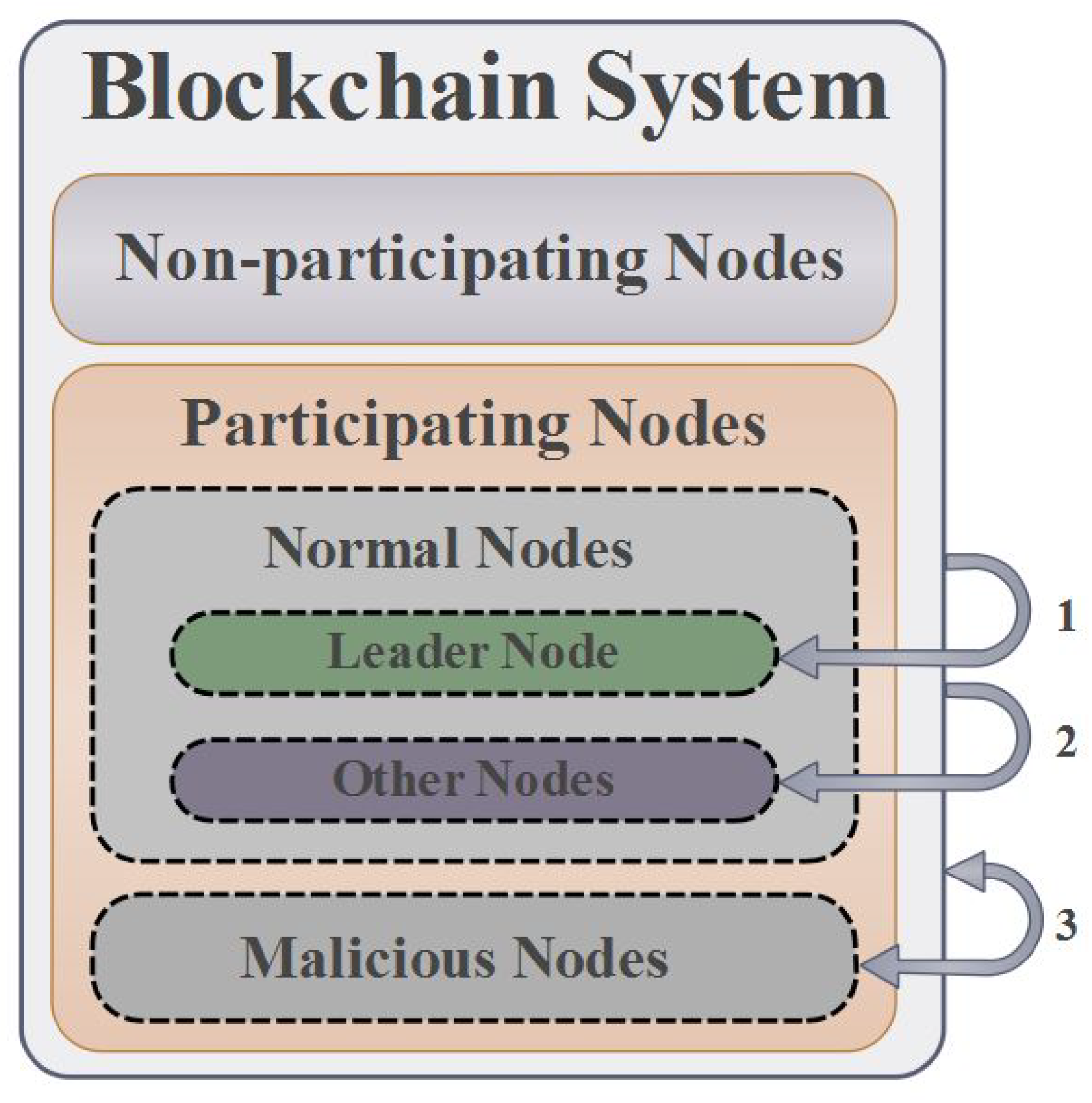

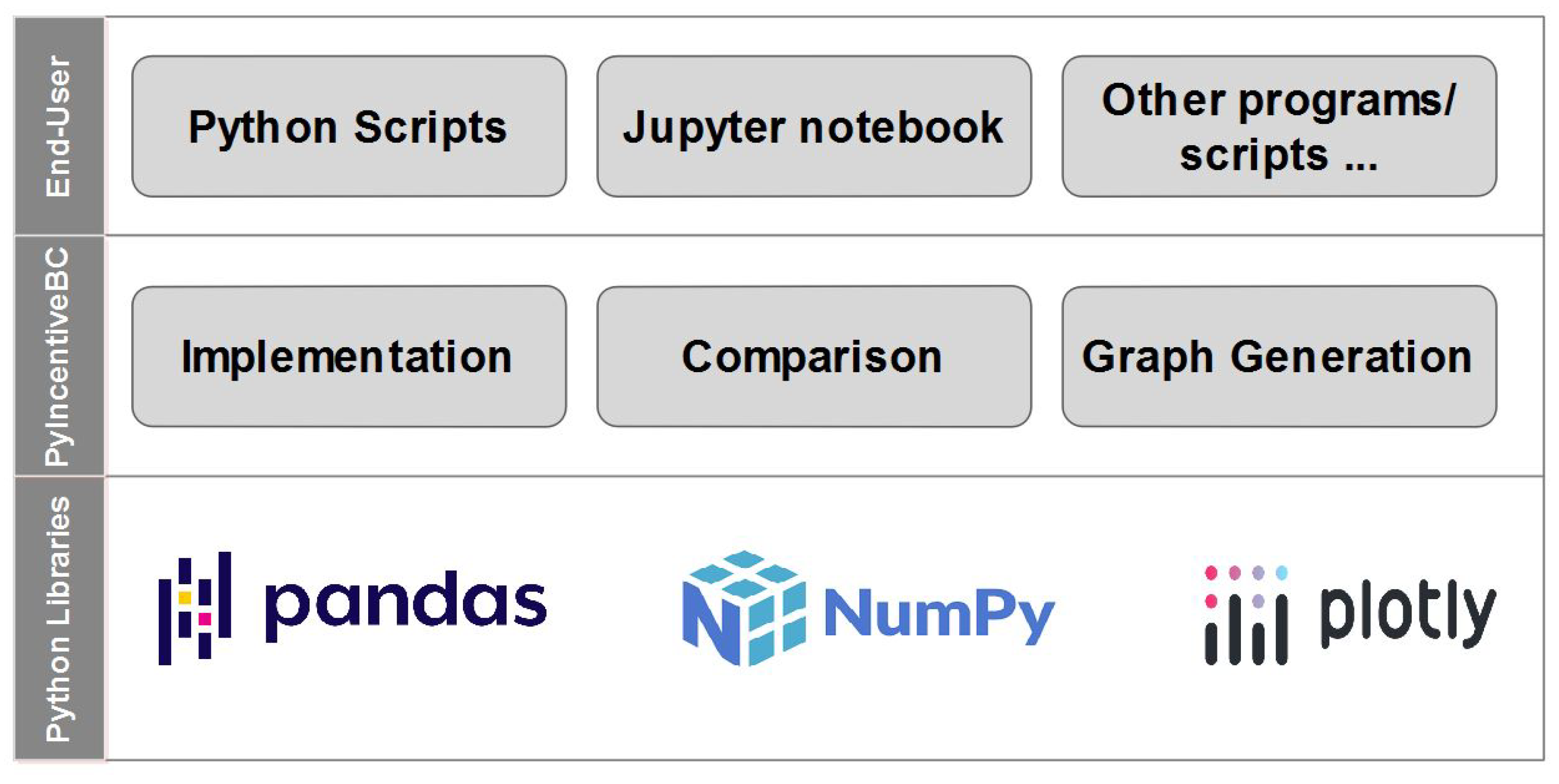

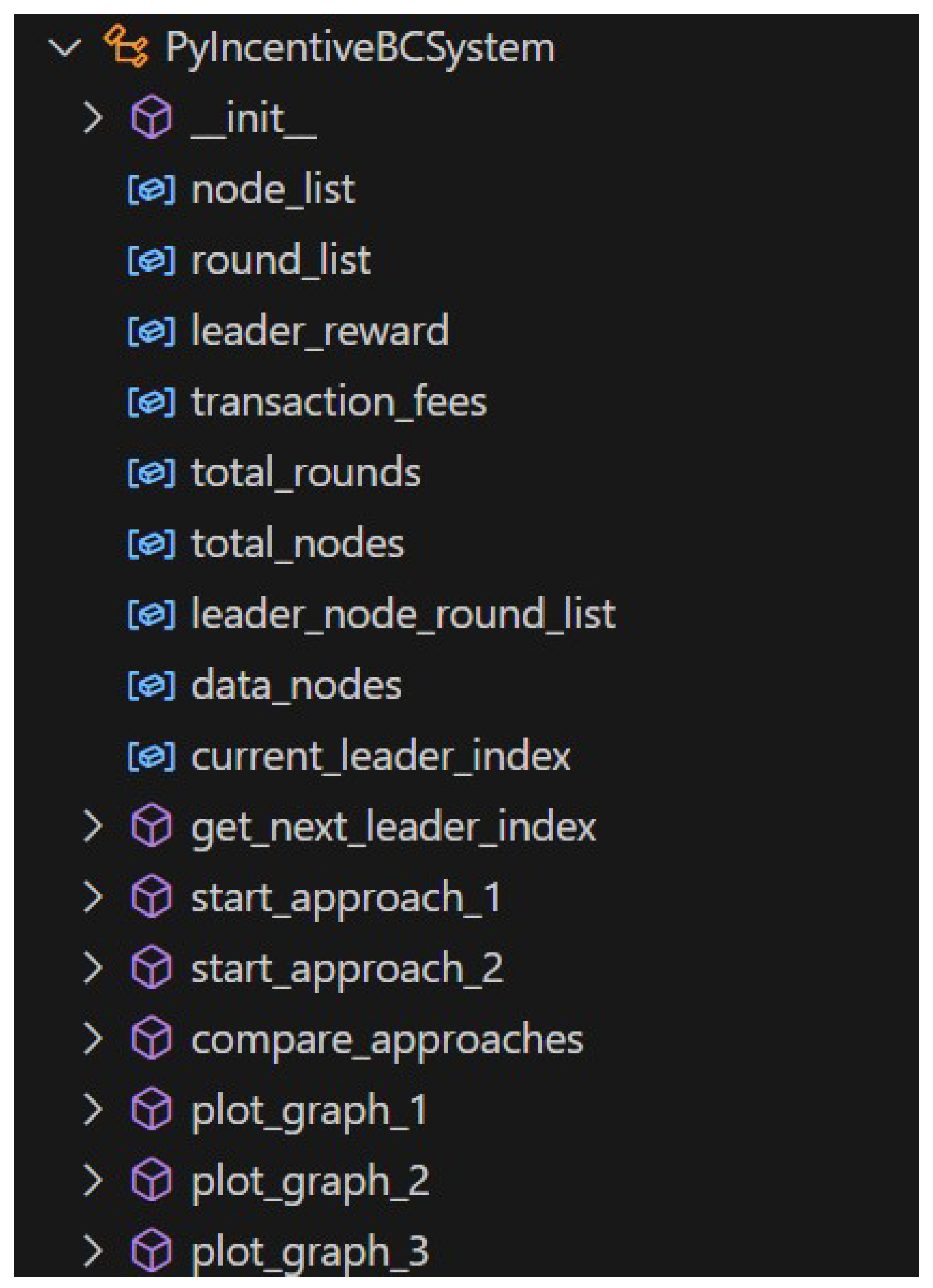


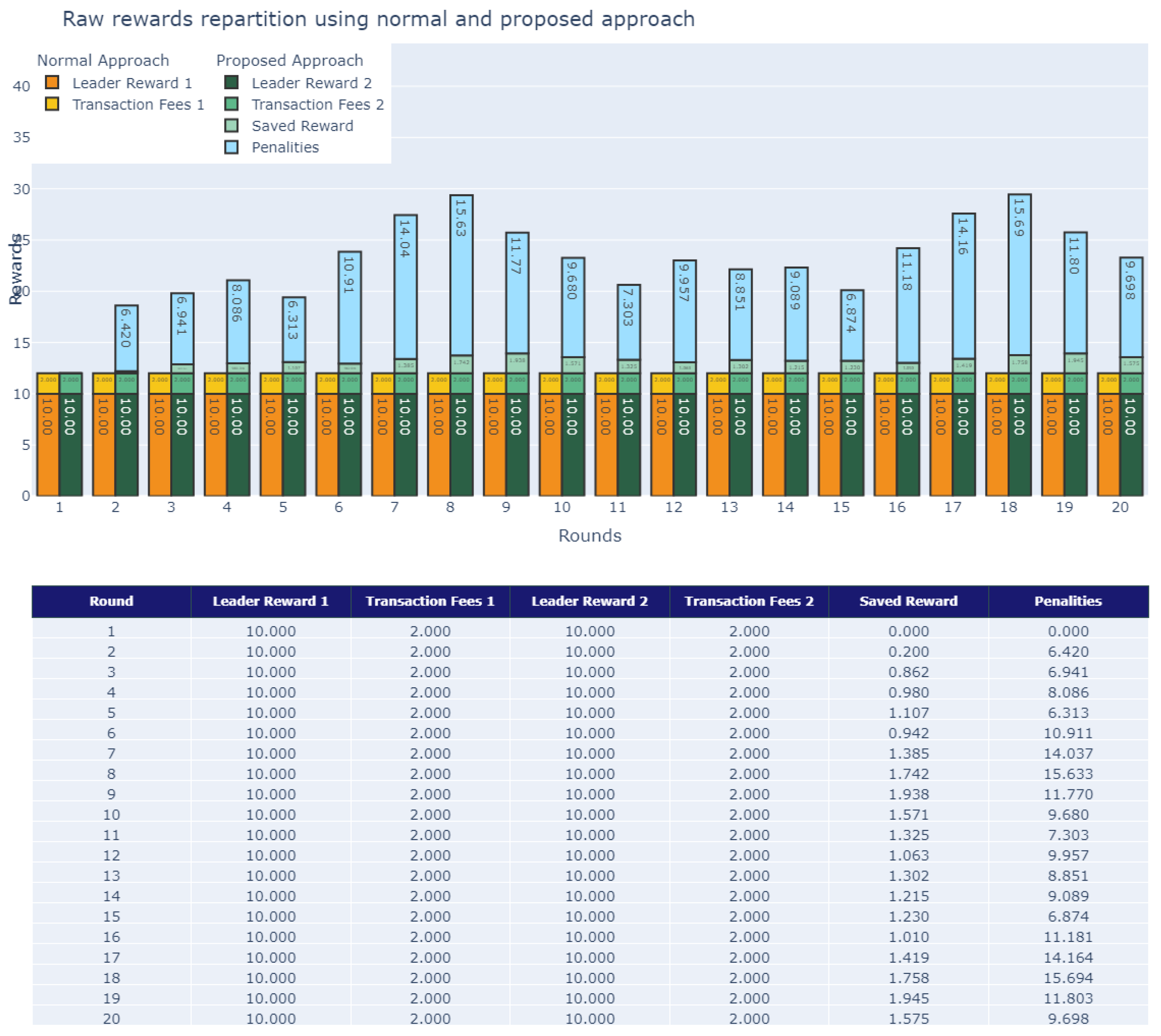

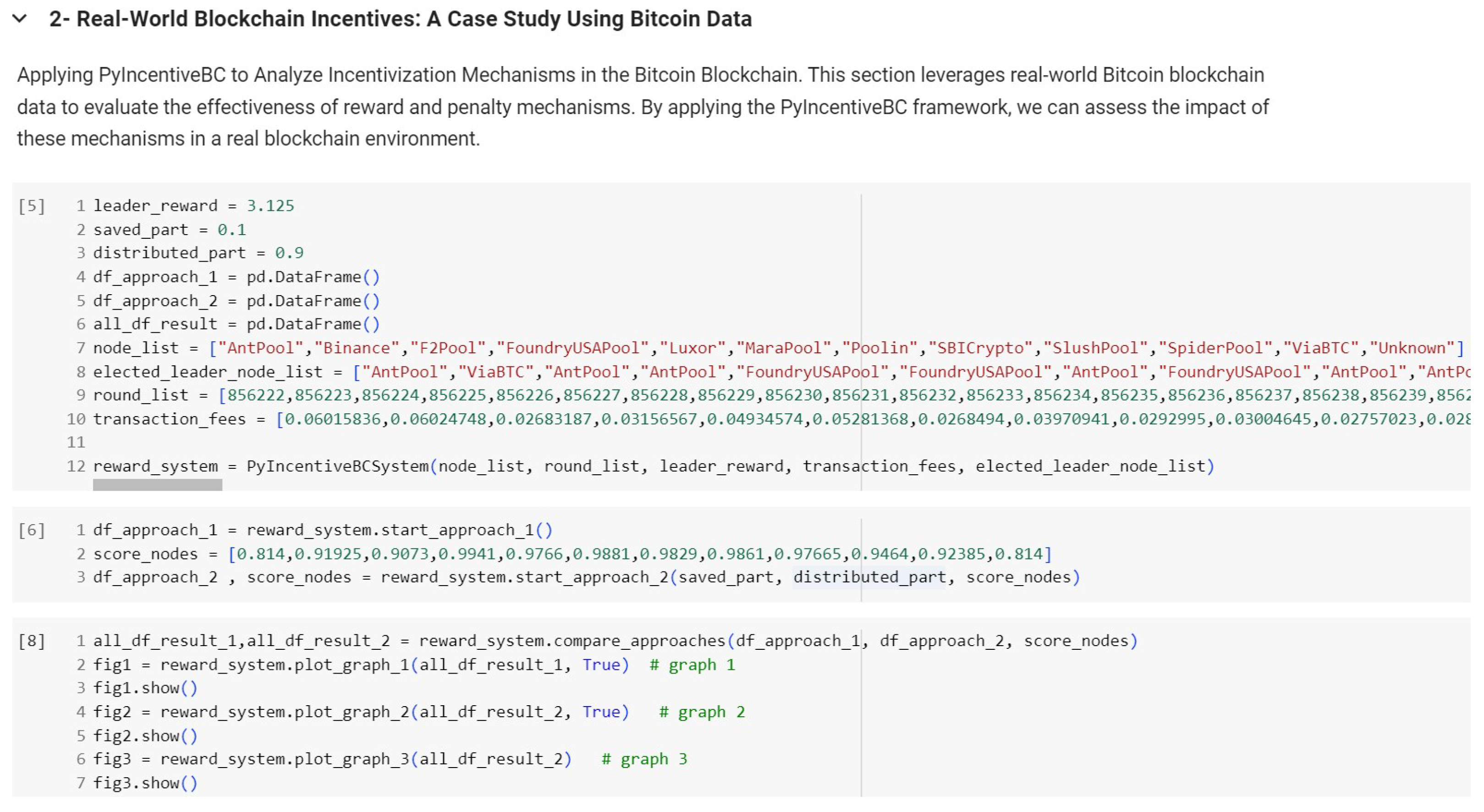
| Block ID | Transaction Fees | Generated Reward | Reward Total per Round | Leader Node |
|---|---|---|---|---|
| 856,222 | 0.06015836 | 3.125 | 3.18515836 | AntPool |
| 856,223 | 0.06024748 | 3.125 | 3.18524748 | ViaBTC |
| 856,224 | 0.02683187 | 3.125 | 3.15183187 | AntPool |
| 856,225 | 0.03156567 | 3.125 | 3.15656567 | AntPool |
| 856,226 | 0.04934574 | 3.125 | 3.17434574 | Foundry USA Pool |
| 856,227 | 0.05281368 | 3.125 | 3.17781368 | Foundry USA Pool |
| 856,228 | 0.0268494 | 3.125 | 3.1518494 | AntPool |
| 856,229 | 0.03970941 | 3.125 | 3.16470941 | Foundry USA Pool |
| 856,230 | 0.0292995 | 3.125 | 3.1542995 | AntPool |
| 856,231 | 0.03004645 | 3.125 | 3.15504645 | AntPool |
| 856,232 | 0.02757023 | 3.125 | 3.15257023 | AntPool |
| 856,233 | 0.02818699 | 3.125 | 3.15318699 | Foundry USA Pool |
| 856,234 | 0.03242674 | 3.125 | 3.15742674 | Foundry USA Pool |
| 856,235 | 0.03383881 | 3.125 | 3.15883881 | Foundry USA Pool |
| 856,236 | 0.03435604 | 3.125 | 3.15935604 | ViaBTC |
| … | … | … | … | … |
| 856,381 | 0.02353156 | 3.125 | 3.14853156 | Unknown |
| 856,382 | 0.05294336 | 3.125 | 3.17794336 | F2Pool |
| Miners | Node’s Block Health | Preventing Empty Blocks | Score | ||||
|---|---|---|---|---|---|---|---|
| AvgBH | CR | Coef. | EBM | CR | Coef. | ||
| AntPool | 98.5% | 0.985 | 1 | 35.7% | 0.643 | 1 | 0.814 |
| Binance | 97.15% | 0.9715 | 1 | 13.3% | 0.867 | 1 | 0.91925 |
| F2Pool | 98.16% | 0.9816 | 1 | 16.7% | 0.833 | 1 | 0.9073 |
| Foundry USA Pool | 98.82% | 0.9882 | 1 | 0% | 1 | 1 | 0.9941 |
| Luxor | 98.72% | 0.9872 | 1 | 3.4% | 0.966 | 1 | 0.9766 |
| MaraPool | 97.62% | 0.9762 | 1 | 0% | 1 | 1 | 0.9881 |
| Poolin | 98.28% | 0.9828 | 1 | 1.7% | 0.983 | 1 | 0.9829 |
| SBICrypto | 98.92% | 0.9892 | 1 | 1.7% | 0.983 | 1 | 0.9861 |
| SlushPool/Braiins Pool | 98.73% | 0.9873 | 1 | 3.4% | 0.966 | 1 | 0.97665 |
| SpiderPool | 94.38% | 0.9438 | 1 | 5.1% | 0.949 | 1 | 0.9464 |
| ViaBTC | 98.67% | 0.9867 | 1 | 13.9% | 0.861 | 1 | 0.92385 |
| Unknown | - | - | - | - | - | - | 0.814 |
| Node | Score | Normal Approach | Proposed Approach | Revenue Variation |
|---|---|---|---|---|
| AntPool | 0.814 | 123.431 | 102.389 | −17.05% |
| Binance | 0.919 | 3.169 | 7.514 | +137.11% |
| F2Pool | 0.907 | 44.249 | 43.928 | −0.73% |
| FoundryUSA | 0.994 | 151.935 | 152.898 | +0.63% |
| Luxor | 0.977 | 0 | 4.962 | +4.962 bitcoins |
| MaraPool | 0.988 | 12.655 | 17.245 | +36.27% |
| Poolin | 0.983 | 0 | 4.994 | +4.994 bitcoins |
| SBICrypto | 0.986 | 9.533 | 14.198 | +48.94% |
| SlushPool | 0.977 | 6.366 | 10.931 | +72.05% |
| SpiderPool | 0.946 | 19.031 | 22.312 | +17.24% |
| ViaBTC | 0.924 | 79.177 | 76.016 | −3.99% |
| Unknown | 0.814 | 60.164 | 51.895 | −13.74% |
Disclaimer/Publisher’s Note: The statements, opinions and data contained in all publications are solely those of the individual author(s) and contributor(s) and not of MDPI and/or the editor(s). MDPI and/or the editor(s) disclaim responsibility for any injury to people or property resulting from any ideas, methods, instructions or products referred to in the content. |
© 2024 by the authors. Licensee MDPI, Basel, Switzerland. This article is an open access article distributed under the terms and conditions of the Creative Commons Attribution (CC BY) license (https://creativecommons.org/licenses/by/4.0/).
Share and Cite
Ouaguid, A.; Hanine, M.; Chiba, Z.; Abghour, N.; Ouzzif, M. PyIncentiveBC: A Python Module for Simulation of Incentivization Mechanism Implemented in Blockchain-Based Systems. Computation 2024, 12, 179. https://doi.org/10.3390/computation12090179
Ouaguid A, Hanine M, Chiba Z, Abghour N, Ouzzif M. PyIncentiveBC: A Python Module for Simulation of Incentivization Mechanism Implemented in Blockchain-Based Systems. Computation. 2024; 12(9):179. https://doi.org/10.3390/computation12090179
Chicago/Turabian StyleOuaguid, Abdellah, Mohamed Hanine, Zouhair Chiba, Noreddine Abghour, and Mohammed Ouzzif. 2024. "PyIncentiveBC: A Python Module for Simulation of Incentivization Mechanism Implemented in Blockchain-Based Systems" Computation 12, no. 9: 179. https://doi.org/10.3390/computation12090179
APA StyleOuaguid, A., Hanine, M., Chiba, Z., Abghour, N., & Ouzzif, M. (2024). PyIncentiveBC: A Python Module for Simulation of Incentivization Mechanism Implemented in Blockchain-Based Systems. Computation, 12(9), 179. https://doi.org/10.3390/computation12090179







